No matter where they settle in the world, South Africans will find a fellow countryman who can make boerewors, or they will learn to make it themselves – that’s how much they miss their traditional sausage.
Boerewors, translated from Afrikaans, a language derived from the Dutch settlers, means farmer’s sausage; the word boer means farmer. It has a rather crumbly texture and was made in the past by individual farmers and hunters.
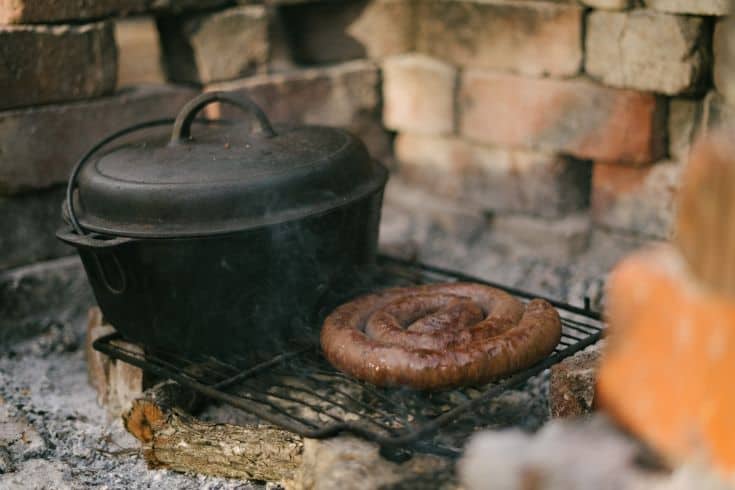
South Africans don’t like the meat for their boerewors ground to a fine texture and, at barbeques around the world where South Africans are present, there will be passionate discussions on the taste, spicing and texture of the boerewors.
If you call it a sausage, a South African might look at you and say, “It’s not a sausage, it’s
boerewors,” with the implication that it’s way above other beef and pork sausages.
Boerewors is most often cooked outdoors at a ‘braai’, and that means it’s not a quick switch-on-the-gas type of barbeque where you cook, eat and leave.
It’s a whole afternoon or evening event of constructing the perfect wood or charcoal fire which must be at just the right heat.
It may take some time to get to the correct temperature, and will involve drinking copious amounts of beer and brandy, with the conversation getting louder and louder, and the stories taller.
Finally, the braai master and his assistants will announce that the fire is ready, meaning whoever is doing the side dishes better have their act together because the meat won’t take more than around half an hour.
Most boerewors these days in the cities and towns are made from beef, but for hunters with access to venison and wild boar, the possibilities are endless in creating boerewors that are a crowd pleaser.
One of the tastiest ones I have ever had was made by a farmer friend from a mixture of venison – duiker and warthog – rather an unusual combination, but it was perfect.
Go to any South African supermarket, and there will be a large range of boerewors – some have bacon added, cheese, and garlic, and some are really spicy with the addition of peri-peri – a type of chili common in Mozambique, a neighboring country on the East Coast of Africa.
Spicing Boerewors
The spices used in a traditional boerewors recipe will include coriander, allspice, cloves, and nutmeg among others.
Now it depends on how much of a purist you are – some people believe that spices should be freshly ground for the best flavor so they will buy whole cloves to grind, whole nutmeg to grate, and dry roast their coriander seeds before crushing them.
Other people use commercially ground spices as you see in this picture. The easiest option is to buy a ready mixed boerewors spice pack, and just add it to the meat. The pack comes with a handy guide to tell you how much spice to add per pound of meat.
Perhaps once you get into making boerewors, try the different methods and see if you can detect a difference in the taste, and let us know in the comment section.
Cooking Boerewors
When you cook boerewors on the braai (barbeque), you do not cut it into individual sausages like you do with pork sausages – it is cooked whole in a coil and only after cooking is it then cut into suitable lengths.
The casing should not be damaged during cooking otherwise the juices will leak out and it will be dry. Often the boerewors are placed inside a grilling basket to make turning the whole coil easier on the braai.
Cooking Time
Boerewors takes around 20 minutes whether it is cooked over hot coals on a braai (BBQ), fried in a pan on the stove, or grilled or baked in the oven. The braai masters will test by cutting off a small piece from the tail of the coil and inspecting it.
If it still shows signs of pinkness it needs to be cooked a bit longer but definitely not too long or it won’t be as tender. This sampling is part of the process of braaiing the perfect boerewors, and not ‘stealing’ bits of meat off the grill!
Earning the Boerewors Label
How do sausages get classified at boerewors? In South Africa it can’t be sold as authentic stuff unless it has:
- ✅ 90% meat content – beef, pork, lamb, or goat ( no other type of meat)
- ✅ 30% or less fat
The following are not allowed as ingredients:
- ❌ offal (excludes the casing)
- ❌ mechanically removed meat
- ❌ soy or vegetable protein
- ❌ color additives
Various spices, permitted additives, and some starch, such as maize meal may be added. These measures were taken to ensure boerewors remains as true to the original as possible.
If a product is labeled ‘wors’ then it’s not genuine boerewors – the special label of ‘boerewors’ being attached only to sausages that have passed the requirements regarding content.
Farmers and hunters make their own boerewors, sometimes using venison from kudu, eland or springbok. Their wors is mixed with pork – from domestic, wild pig or warthog.
According to the current South African legislation that defines boerewors, it’s not boerewors, but is probably the most authentic way it was made back in the days of the pioneers. Instead, if it is sold it must be labeled with the name of the predominant meat used – for example kudu wors.
If you are a hunter then go ahead and use your venison for making ‘boerewors’ – the texture and the spicing are just as important as the meat, and it must include some pork for the required taste and fat content.
Refining Your Skills
Once you start making boerewors at home, you may want to tweak the recipe until everyone agrees on the taste, spiciness, and texture. Then you can start experimenting by adding cheese or garlic, or whatever customized flavor you wish to create.
Super-Secret Tips from a South-African
- The meat for boerewors should not be frozen – fresh is best.
- The pork fat is necessary – a certain amount of fat is good as it makes the product tastier and juicier.
- Some recipes call for the addition of spek – the Afrikaans word for bacon. The smokiness of the bacon gives an additional flavor to the boerewors, which is then marketed as spekwors.
- The bacon can be obtained in chunks from your local butcher, and is sometimes sold as ‘speck’ (note the difference in spelling to the Afrikaans word), although genuine speck, a lightly smoked Italian ham, is made from the deboned leg of pork rather than belly fat.
- Chunks of cheese may sometimes be added – to make kaaswors. This is absolutely delicious served warm with the cheese melting into the meat.
Boerewors Casing
Cleaned intestines are usually used for the casings, and come packed with salt which needs to be rinsed off before carefully threading the casing onto your sausage stuffer. Boerewors is a fairly thick sausage so a 36 mm (1.4 inches) casing or one close to these dimensions is good to use.
Equipment
If you are an old hand at making various sausages then you won’t want to know about equipment as you’ll have your own. If you have never done this before then you will need a meat grinder/sausage stuffer. I prefer this all-in one-version that is fairly sturdy to get the job done.
If you are not sure about which meat grinder brand to buy, then this video gives you the reviewer’s five best options, which may help you make a choice:
If your meat grinder doesn’t come with a sausage stuffer attachment, you may need to buy a separate vertical sausage stuffer which is probably better than the ones that are horizontal. This is mainly because, unless you have super long arms, it’s hard to turn the handle and control the sausage at the same time, making it more of a two-person job.
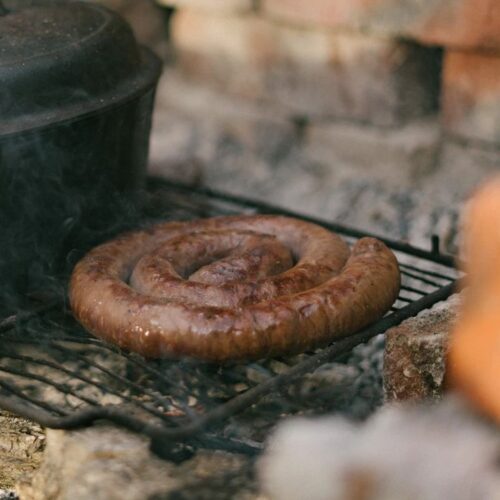
Boerewors Recipe
Ingredients
- 4.5 lbs. beef = 2.5 kgs, top round roast or brisket, silverside
- 2.5 lbs. fatty pork cut = 1.1 kgs, shoulder, neck or belly
- 50 ml coriander seeds
- 1/2 teaspoon nutmeg fresh grated, scant 1/2 teaspoon
- 1/4 teaspoon ground cloves 1.5ml
- 1 teaspoon ground allspice 5 ml
- 5 teaspoons salt = 25 ml
- 1 teaspoon fresh ground black pepper
- 125 ml Malt (dark) vinegar
- 50 ml Worcestershire sauce
- 1 pack wide sausage casing
Instructions
- Trim the beef and pork, discarding any sinew, and trim into longish pieces about 3 inches wide. This just makes it easier for the meat grinder (South Africans call it a mincer) to process.
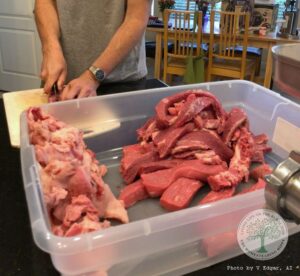
- Place all your trimmed meats in a large container.
- Put the meat mix through the grinder on a large blade.
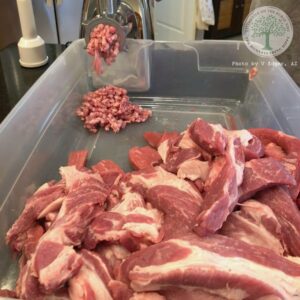
- Dry roast the coriander seeds in a pan on medium heat, stirring to make sure they don’t burn, then remove from the heat when they are a golden brown color.
- Crush the seeds coarsely in a food processor or use a mortar and pestle.
- Add the dry spices, the vinegar and the Worcestershire sauce to the meat, or if using a readymade boerewors spice mix then follow the instructions on the pack, then add to the meat.
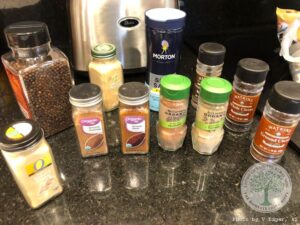
- Mix and leave in the fridge for two hours for the flavors to absorb.
- Put through the grinder on a medium size blade which enables the spices to be incorporated through the meat.
- Use your sausage stuffer to fill the casings with the boerewors mix.
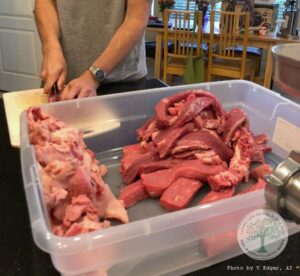
- Roll your coils of boerewors neatly, ready to braai, and the extra can be bagged and frozen until you need them.
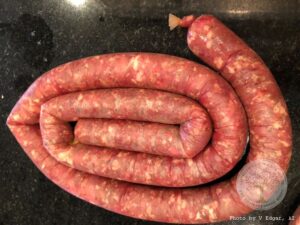
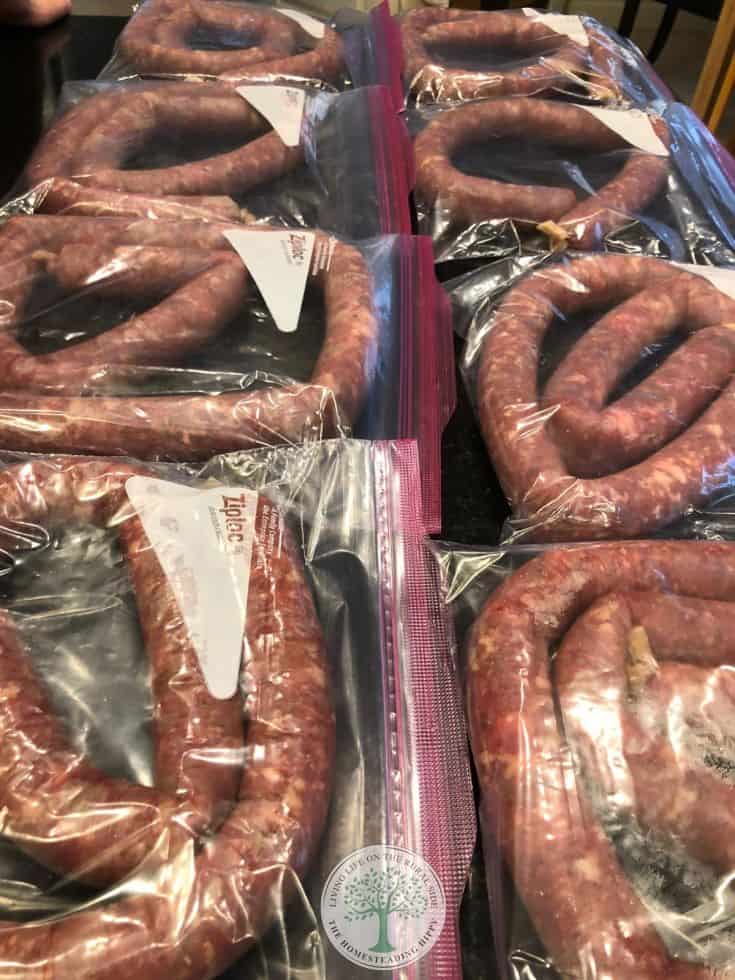
Side Dishes for Boerewors
Now you have your boerewors, you are probably wondering what to serve it with. South Africans eat their boerewors with stywe pap a stiff porridge made from maize (corn) meal.
It is not corn flour, but coarser ground corn that is cooked with water and a little salt to a stiff porridge-like consistency.
If you like it even drier, then you use less water and make krummel pap which is similar to couscous in texture, although the grains are smaller. I would highly recommend Iwisa, a South African-made maize meal.
This is a brand I have used often and will give you the traditional taste and texture of pap. Other non-South African brands of maize meal just do not have the same taste and consistency and you may be disappointed with the results.
A tip for cooking pap is to boil the water, add the maize meal, mix it thoroughly with a fork – a spoon will be difficult – and immediately turn down the plate to very low heat, as the mix can burn easily.
Put the lid on and leave to gently steam, checking occasionally and stirring with the fork. It should be done in about 25 to 30 minutes.
Pap and wors, as it is fondly known across Southern Africa, is not complete without being smothered in a tasty sauce made from onions, tomatoes, and spices. If you would like to see how to make this sauce, known as sous watch here:
Everyone has their own version, so if you see certain spices used in the video that are not locally available feel free to substitute them with similar spices.
A popular picnic option is to simply put your piece of warm boerewors straight off the grill into a freshly sliced hotdog roll, slather it with some fried onions, mustard, and tomato sauce, and enjoy.
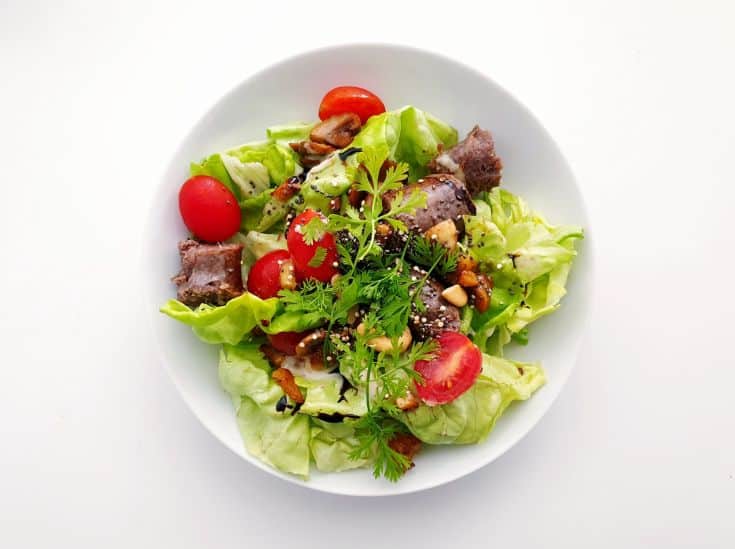
For dinners with family and friends boerewors is enjoyed with pap and sauce with a green salad. If you are counting calories, simply serve boerewors with salad greens as you see above.
Have you made boerewors yourself? Do share your tips below, and don’t forget to pin this for later!
Recipe Variations
There are a few different ways to make boerewors. This is done by altering the meat mixture ever so slightly to create something new. Examples include:
- Adding cheese to the mixture – like I mentioned before – to make kaaswors
- Using game meat (venison) instead of beef i.e. kudu, springbok, blesbok, etc.
Now that we know how to make it, what can we make into a meal with boerewors?
Tomato, Onion, and Boerewors Bredie
So, if you’re not familiar with it, bredie is a tomato stew that’s typically made with mutton and spiced with things like cinnamon, cardamom, chili, and ginger. This particular recipe adds boerewors to the mix. Try it yourself and see what you think.
Boerewors Sishebo
Two words: boerewors stew. Need I say more? It’s rich, flavorful, and filling. You’ll probably be going for seconds of this one. Try it and see.
Chakalaka and Boerewors
Chakalaka is a mixture of veggies, onions, chili, and tomatoes. It’s a great addition to any meal and when you add boerewors to it…well, you get a match made in heaven. Try it and see for yourself.
Boerewors Patties
Yes, this is a thing. Making boerewors is a time-consuming process and not everyone has the patience for it.
Additionally, it can require a bit of practice (especially if you’re doing everything by hand) to get it right. Thankfully, there’s a quick and easy solution to this problem; make a boerewors patty.
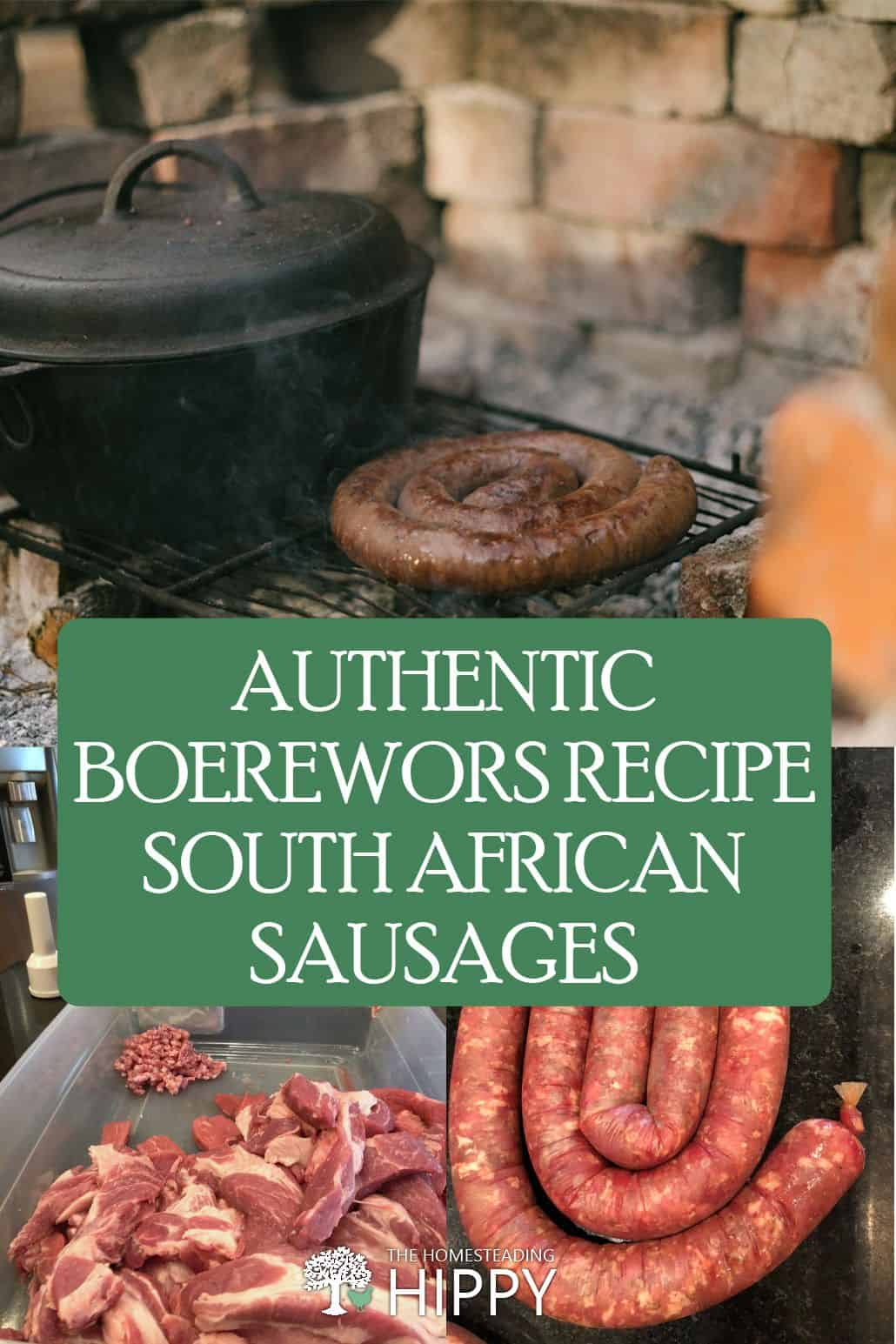

As a child I wanted to grow up and marry a farmer… simply because it was so different from my life right on the shores of the ocean. Well, I didn’t marry a farmer but a surfer instead. The urge, however, to grow stuff and make great food for a big family never left. We are on acreage with a sea view and easy access to fresh caught crayfish and other seafood – the best of both worlds. As an artist and writer I enjoy creating new recipes, tweaking traditional ones, and sharing the results not only with family and friends, but online. Mee the rest of the team at this page.

yes i bought a bag of the seasoning to make this sausage but it does not tell me how i need to use for making it. i don’t want to add to much by accident
around 30 to 45 gm per kilo is around right.Sorry no american/imperial cconversions
I once had a boerewors recipe from an old My Fair Lady magazine (now sadly lost) that used claret (red wine) instead of vinegar. I remember making it and tasted really good. But of course vinegar does give word a good edge. I shall have to try out your recipe.